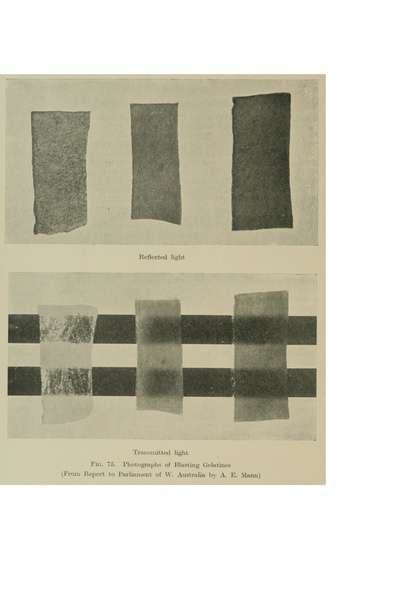Gelignite
Gelignite (/ˈdʒɛlɪɡnaɪt/), also known as blasting gelatin or simply jelly, is an explosive material consisting of collodion-cotton (a type of nitrocellulose or guncotton) dissolved in either nitroglycerine or nitroglycol and mixed with wood pulp and saltpetre (sodium nitrate or potassium nitrate).
It was invented in 1875, by Swedish chemist Alfred Nobel, who also invented dynamite. It is more stable than dynamite, but can still suffer from "sweating" or leaching out nytroglycerine.[1][2] Its composition makes it easily moldable and safe to handle without protection, as long as it is not near anything capable of detonating it.
One of the cheapest explosives, it burns slowly and cannot explode without a detonator, so it can be stored safely.[3]
In the United Kingdom, an explosives certificate, issued by the local Chief Officer of Police, is required for possession of gelignite.[4] Due to its widespread civilian use in quarries and mining, it has historically been used by irregular or paramilitary groups such as the Irish Republican Army[5] and the Ulster Volunteer Force[6] who often used gelignite as a booster.
Frangex
The 1970s saw Irish Industrial Explosives Limited producing annually 6,000 tonnes of Frangex, a commercial gelignite intended for use in mines and quarries. It was produced at Ireland's largest explosives factory in Enfield, County Meath. The Gardaí and the Irish Army patrolled the area, preventing the IRA from gaining direct access.
However, indirectly, the Provisional Irish Republican Army (PIRA) acquired amounts of the material. At the time of his arrest 3.5 kilograms (7.7 lb) was found in the possession of Patrick Magee[7] and 300 kilograms (660 lb) discovered in a hijacked road tanker in January 1976.[8]
PIRA volunteer, later informer, Sean O'Callaghan estimated that planting 25 pounds (11 kg) of Frangex would kill everyone within a 60-foot (18 m) radius.[9] The Real IRA (RIRA) also acquired Frangex, and, in December 2000, eighty sticks were discovered on a farm in Kilmacow, County Kilkenny, near Waterford.[10]
References
- Pickett, Mike (2004). Explosives Identification Guide. Cengage Learning. ISBN 978-1-4018-7821-4.
- Braddock, Kevin (3 February 2011). "How to handle gelignite". Wired. Retrieved 30 August 2019.
- Irish Industrial Explosives Limited website; accessed 28 July 2014.
- CITB Construction Ste safety, A13 Statutory Forms
- Coogan, Tim Pat (January 2002). The IRA. Palgrave Macmillan. p. 379. ISBN 978-0-312-29416-8.
- "Orange Bombs, part 2: Loyalists and explosives, 1972-1994". Balaclava Street. Retrieved 2020-08-06.
- Stewart Tendler, "Brighton charge: man in court today", The Times, 1 July 1985.
- Christopher Walker, "Dublin Government embarrassed by Ulster explosives haul as hunt for source continues", The Times, 20 January 1976.
- Whitaker, James, "John and Norma Aghast at Wedding", The Daily Mirror, 23 May 1998; accessed 23 June 2015.
- "Man Released After Explosives Questioning", BBC News; accessed 30 August 2019.
